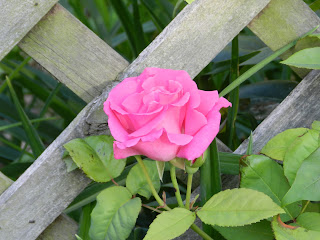Independence Day
aka July 4th is for most Americans a day of family, food and
fireworks. Adults and soldiers may reflect
on the price of freedom while kids run crazy with sparklers, hotdogs and
sunburns.Parades crawl happily by with politicians, tractors and folks dressed
in red, white and blue.
I love a good
parade: I get teary when local soldiers (past or present) march by with the
flag, my heart beats with excitement if there’s a band playing marching songs,
and I take pictures of veterans, the Bishop Hill High Society Band, and a float
made from a lawn mower, a garden wagon, and kids. I’ll sit through rain, sun and scorching
temperatures with pride in all that’s been assembled to celebrate our country’s
independence.
But, does that
independence really translate to the freedom to garden in your own backyard you
may ask? OK, probably no one has ever
asked that but I’m going to delve into garden freedoms today.
I’ve written
about laws regarding the parking strip, utility regulations and trees. That’s been covered and now let’s dig a
little deeper into your garden freedoms.
Anyone whose
read my articles knows I’m on the side of less federal regulations, less local government
interference in the daily lives of it’s citizens and the encouragement of
personal freedom as long as it doesn’t harm others. Sounds simple and of course in legal terms
it’s never simple. It’s because the
translation of words can be vastly different between people. My idea of what “government interference in
the daily lives of its citizens” may be totally different than your version.
On the flip
side, one of the benefits of our freedoms is the ability to debate these issues
until someone finally calls “Uncle!” At
some point, we must agree on what or how much government control is needed to
protect the citizens and their way of life while still protecting our
individual freedoms. So simple to say –
so not simple to do.
We also have
what is gently called “internet hysteria” regarding most anything, everything
and often nothing. This applies to laws
governing gardening and on a bigger scale the production of food. Does the Food and Drug Administration have
the right to regulate what and how we grow food in our backyard gardens? Will the farm bills eventually regulate
organic gardens out of business? Will
farmers’ markets be outlawed the same as the sale of unprocessed milk? The list from individual interest groups is
endless.
Will the term
“food production facility” (used in some legislation applicable to all farm,
ranch, orchard, vineyard, aquaculture and confined animal feeding facilities)
also include any place that grows food – even a backyard garden?
On a state or
local level, there may be weed laws.
Near us, Chicago has one of the most ambiguous and highly enforced weed
laws with the sole purpose of generating revenue through fines. Most states have laws protecting native
plants and wildlife. Other towns prohibit
vegetable gardens in the front yard and homeowner associations are often so restrictive
a home owner gives up the freedom of individual choices on anything visible
outside of the home. (Granted it’s a
choice to live under the rules when you purchase a home governed by these
associations.)
Some cities and
states have laws governing composting, water use (both restricting or insisting
you water), fencing and hedges, height of plants, what consists of “noxious
weeds”, and what pesticides and fertilizers a homeowner may apply. Others have laws regulating the kind and
number of animals you may have in your yard, beekeeping, dovecotes, height of
turf and what’s considered wildflowers.
Most states
prohibit killing birds and some have restrictions on how to handle an injured
bird. Laws prohibiting the use of
firearms to kill raccoons, squirrels and other wild critters are in most
towns. Hint: call your local Animal Control office.
For the sake of
the more extroverted gardener, it’s typically against the law to garden in the
nude within city limits. And that piece
of gardening law information is my final and most important for the average
Galva News reader.
Enjoy your July
4th Independence Day celebrations and count your Blessings you live
in this beautiful land of milk and honey.
May it always stand tall and proud in the way it governs and gardens.


.JPG)
.JPG)
.jpg)
.JPG)



.JPG)
.JPG)
.JPG)
.JPG)
.JPG)
.JPG)
.JPG)
.JPG)
.JPG)
.JPG)





.JPG)




.JPG)
.JPG)
.JPG)


.JPG)
